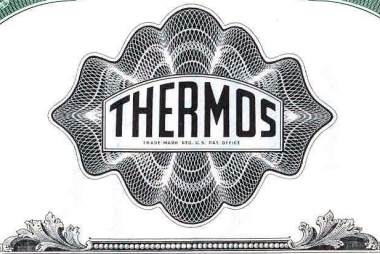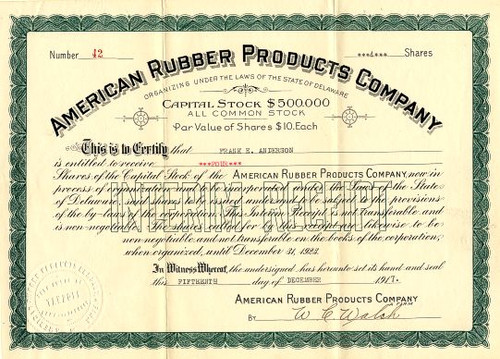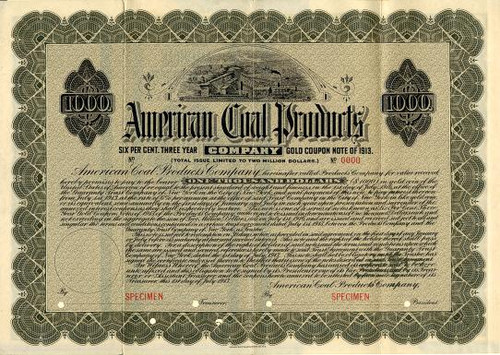Beautifully engraved SCARCE SPECIMEN certificate from the American Thermos Products Company. This historic document was printed by the Franklin Lee Division - American Banknote Company in 1956 and has an ornate border around it with a vignette of the company logo. This item has the printed signatures of the Company's President and Secretary. 
Certificate Vignette In 1907, Thermos GmbH sold the Thermos trademark rights to three independent companies: The American Thermos Bottle Company of Brooklyn, NY; Thermos Limited of Tottenham, England; Canadian Thermos Bottle Co. Ltd. of Montreal, Canada. The three Thermos companies operated independently of each other, yet developed the Thermos vacuum flask into a widely sought after product that was taken on many famous expeditions, including: Lieut. E.H. Schackelton's trip to the South Pole; Lieut. Robert E. Peary's trip to the Arctic; Colonel Roosevelt's expedition to Mombassa and into the heart of the African Congo with Richard Harding Davis. It even became airborne when the Wright Brothers took it up in their airplane and Count Zepplin carried it up in his air balloon. In 1952, The American Thermos Bottle Company acquired controlling stock in The Plastene Corporation in Crawfordsville, IN, a manufacturer of injection molded plastic products. This acquisition gave Thermos 2 injection molding facilities in the U.S., and greater expertise in this emerging technology. In 1953, a subsidiary company, Plastene Ltd. of Canada, was formed to produce molded plastic parts for Canadian Thermos. Branching out further in 1955, The American Thermos Bottle Company acquired control of Hemp and Company, Inc. of Macomb, IL, manufacturers of the "Little Brown Jug" and other insulated jugs and chests as well as Duncan Hines outdoor grills. To reflect the growing diversity of products, the names of the North American companies were changed in 1956. The American Thermos Bottle Company became The American Thermos Products Company, and the Canadian Thermos Bottle Co. Ltd. changed its name to Canadian Thermos Products Limited. In 1957, 50 years after the company started in the U.S., U.K. and Canada, the Thermos brand vacuum bottle was known almost universally for use with food and beverages. But it also proved useful in science, medicine and industry. It had been used in various instruments measuring electric power, rate of climb in airplanes, detection of oil deposits and weather recording. It had also been used to transport rare tropical fish and to preserve and transport blood plasma, serums, bones, tissues and insulin. During the first 50 years, Thermos had a relatively stable ownership. In the next three decades there were three major ownership changes. In 1960, the U.S., U.K. and Canadian companies were purchased by the King-Seeley Company to form the King-Seeley Thermos Company. In 1965, King-Seeley Thermos purchased Structo Manufacturing of Freeport, IL, a manufacturer of outdoor cooking grills. Ownership changed hands again in 1968 when King-Seeley Thermos Company became a wholly owned subsidiary of Household Finance Company of Chicago, which later became Household International. That corporation was attempting to diversify outside its consumer finance business and eventually bought and sold companies involved in transportation, retailing and manufacturing. By 1971, over 50% of the production of Thermos Limited of England was being exported to over 100 different companies. The company was presented with the Queen's Award to Industry for these export achievements. The U.S. operation continued to expand. In 1972, an additional parcel of land was purchased at the Taftville, CT operation and the following year an adjoining building was purchased. In 1974, a second addition was built onto the Macomb, IL plant. In 1982, as part of a parent company reorganization, the King-Seeley name began to be replaced by Household International. In 1983, Household expanded its manufacturing holdings by acquiring the Wallace Murray Company. The combined operation came to be known as Household Manufacturing. For the next 6 years, Household restructured its manufacturing operations. Several production facilities were moved from northern U.S. locations where they had been long established, to sites in various southern states. A major product introduction in 1985 was the Coffee Butler, a vacuum insulated glass carafe. The product was an enormous success and became one of the top housewares products in North America in 1985. In late 1986, Household Manufacturing merged Thermos with Structo to form a single consumer products division in the U.S. In the 5 years between 1983 and 1988, the owner of Thermos, Household International, had restructured the company by closing facilities in Norwich and Taftville, CT; Macomb, IL and Anaheim, CA. Also, the operations of Thermos and Structo had been merged.
About Specimens Specimen Certificates are actual certificates that have never been issued. They were usually kept by the printers in their permanent archives as their only example of a particular certificate. Sometimes you will see a hand stamp on the certificate that says "Do not remove from file". Specimens were also used to show prospective clients different types of certificate designs that were available. Specimen certificates are usually much scarcer than issued certificates. In fact, many times they are the only way to get a certificate for a particular company because the issued certificates were redeemed and destroyed. In a few instances, Specimen certificates we made for a company but were never used because a different design was chosen by the company. These certificates are normally stamped "Specimen" or they have small holes spelling the word specimen. Most of the time they don't have a serial number, or they have a serial number of 00000. This is an exciting sector of the hobby that grown in popularity and realized nice appreciation in value over the past several years. Company history from Thermos Press Information.

Certificate Vignette
About Specimens Specimen Certificates are actual certificates that have never been issued. They were usually kept by the printers in their permanent archives as their only example of a particular certificate. Sometimes you will see a hand stamp on the certificate that says "Do not remove from file". Specimens were also used to show prospective clients different types of certificate designs that were available. Specimen certificates are usually much scarcer than issued certificates. In fact, many times they are the only way to get a certificate for a particular company because the issued certificates were redeemed and destroyed. In a few instances, Specimen certificates we made for a company but were never used because a different design was chosen by the company. These certificates are normally stamped "Specimen" or they have small holes spelling the word specimen. Most of the time they don't have a serial number, or they have a serial number of 00000. This is an exciting sector of the hobby that grown in popularity and realized nice appreciation in value over the past several years. Company history from Thermos Press Information.








